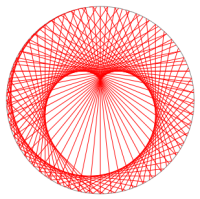Digit recognition, Softmax
在这篇博客中,我将使用softmax模型来识别手写数字。文章的第一部分是关于softmax模型的理论推导,而第二部分则是模型的实现。softmax的本质是一个线性模型,所以推导所需要的理论在我之前的一篇博客Generalized Linear Model已经详细介绍过了。softmax是逻辑回归(logistic regression)的推广:逻辑回归使用Bernoulli分布(二项分布),而softmax使用多项分布。
softmax模型
假设\(y\)取值于\(\{1, 2, \dots, k\}\),也就是说数据集中包含\(k\)类。一般来说对于输入特征\(x \in \mathbb{R}^{n+1}\),我们会规定\(x_0 = 1\)。也就是说实际上输入特征是\(n\)维的,引入\(x_0=1\)是为了可以将线性方程写成
如果去掉\(x_0\)这个维度,那么关于\(x\)的线性方程就要写成
在本文中我们只考虑特征\(x \in \mathbb{R}^n\)具有真实的\(n\)维,也就是说去除\(x_0\)维度。最后假设训练集有\(m\)个数据点:\(\{(x^{(1)}, y^{(1)}), \dots, (x^{(m)}, y^{(m)})\}\)。
我们的目标是根据训练集建立一个线性模型进行分类。首先我们引进\(k\)个正参数:\(\phi_1, \dots, \phi_k\),并且假设\(y\)遵循多项分布
这些参数是跟输入特征\(x\)有关,我们希望根据特征\(x\)算出所有参数,而这些参数根据上述多项分布给出y属于各个类的概率。
推导线性模型的第一步是将概率分布写成指数形式,为此,我们先引入一个函数\(1\{P\}\):
那么上述多项分布可以写成
其中 \(b(y) = 1, a(\eta) = \log\left(\sum_{j=1}^k \phi_j\right)\),
推广的线性模型(具体看Generalized Linear Model)假设
也就是
这里\(W_i\)是一个\(n\)维的列向量,\(b_i\)是一个实数。这样此线性模型由\(T(y)\)的期望值给出:
如果我们定义
并且定义softmax函数\(\sigma: \mathbb{R}^k \to \mathbb{R}^k\)为
那么上述的线性模型(\(\ref{model1}\))可以简化为
给定训练集,我们通过最大可能性估计(maximum likelihood estimation)来学习\(W\)和\(b\)。对于任意一个数据点\((x^{i}, y^{i})\)
最后等式中的\(<,>\)是内积,\(\log h_{W, b}(x^{(i)})\)表示log函数作用在\(h_{W, b}(x^{(i)})\)的每个分量上。因此我们要最大化
模型实现
我们将用上面推导出来的softmax模型识别手写数字。这些数据从LeCun Yann的网页得到。说明一下的是我用jupyter notebook使用python3运行下面代码的。使用到的第三方库有 numpy, matplotlib 和 tensorflow。
import sys
py = 'Python ' + '.'.join(map(str, sys.version_info[:3]))
print('Jupyter notebook with kernel: {}'.format(py))
import gzip
import time
from urllib.request import urlopen
import numpy as np
import matplotlib.pyplot as plt
import tensorflow as tf
Jupyter notebook with kernel: Python 3.6.3
首先要获取训练集。因为文件是gz格式的,所以要使用gzip来解压。解压后的文件格式在网页上有说明,我根据说明写出了下面的函数get_samples。
def get_samples(images, labels):
img_num = int.from_bytes(images[4:8], byteorder='big')
lbl_num = int.from_bytes(labels[4:8], byteorder='big')
assert(img_num == lbl_num)
print('There are {} samples.'.format(img_num))
row = int.from_bytes(images[8:12], byteorder='big')
col = int.from_bytes(images[12:16], byteorder='big')
img_size = row * col
x, y = [], []
for i in range(img_num):
img_offset = 16 + img_size * i
lbl_offset = 8 + i
img = np.array(list(images[img_offset:img_offset+img_size]))
lbl = labels[lbl_offset]
lbl = np.array([i==lbl for i in range(10)], dtype=np.int8)
x.append(img)
y.append(lbl)
return x, y
get_samples的输入是解压后图像文件和对应的标记文件的字节串,输出为(x, y),其中x是包含表示图像的列表,每个元素是一个28x28=784维的向量。y是对应x的数字标记。下面是获取所有训练集并且展示其中前25个数据点的代码。
images_url = 'http://yann.lecun.com/exdb/mnist/train-images-idx3-ubyte.gz'
labels_url = 'http://yann.lecun.com/exdb/mnist/train-labels-idx1-ubyte.gz'
images = gzip.decompress(urlopen(images_url).read())
labels = gzip.decompress(urlopen(labels_url).read())
train_x, train_y = get_samples(images, labels)
There are 60000 samples.
r = c = 5
fig, ax = plt.subplots(r, c)
for i in range(r):
for j in range(c):
k = i * c + j
img = train_x[k]
img = img.reshape((28, 28))
lbl = train_y[k].argmax()
lbl = str(lbl)
ax[i, j].imshow(img, cmap='gray_r')
ax[i, j].set_title(lbl)
ax[i, j].axis('off')
plt.subplots_adjust(hspace=0.7)
plt.show()
接着我们使用tensorflow训练得到参数\(W\)和\(b\)。我们是要最大化等式\((\ref{loglike})\)中的\(l(W, b)\),这等价于最小化\(-l(W, b)\)。
x = tf.placeholder(tf.float32, [None, 784])
W = tf.Variable(tf.zeros([784, 10]))
b = tf.Variable(tf.zeros([10]))
y = tf.nn.softmax(tf.matmul(x, W)+b)
y_ = tf.placeholder(tf.float32, [None, 10])
cost = tf.reduce_mean(-tf.reduce_sum(y_ * tf.log(y), reduction_indices=[1]))
train_step = tf.train.GradientDescentOptimizer(0.00001).minimize(cost)
sess = tf.InteractiveSession()
tf.global_variables_initializer().run()
begin = time.time()
for i in range(200):
sess.run(train_step, feed_dict={x: train_x, y_: train_y})
end = time.time()
print('Runtime: {} seconds'.format(end-begin))
Runtime: 107.31829977035522 seconds
为了检测参数的好坏,我们从刚才的网页上下载测试集并计算错误率:
images_url = 'http://yann.lecun.com/exdb/mnist/t10k-images-idx3-ubyte.gz'
labels_url = 'http://yann.lecun.com/exdb/mnist/t10k-labels-idx1-ubyte.gz'
images = gzip.decompress(urlopen(images_url).read())
labels = gzip.decompress(urlopen(labels_url).read())
test_x, test_y = get_samples(images, labels)
There are 10000 samples.
pred_y = sess.run(y, feed_dict={x: test_x})
result = [0, 0]
for ty, py in zip(test_y, pred_y):
result[ty.argmax()==py.argmax()] += 1
error_rate = result[0] * 100 / sum(result)
print('Error rate is: {}%'.format(error_rate))
Error rate is: 8.9%
让我们看看对于测试集前25个数据的预测情况。图像上面的数字是预测的数字,紧接的"✔"表示预测成功,“✖”表示预测失败。
r = c = 5
fig, ax = plt.subplots(r, c)
for i in range(r):
for j in range(c):
k = i * c + j
img = test_x[k]
img = img.reshape((28, 28))
lbl = test_y[k].argmax()
lbl = str(lbl)
pred = str(pred_y[k].argmax())
ind = '✔' if lbl == pred else '✖'
title = '{}{}'.format(pred, ind)
ax[i, j].imshow(img, 'gray_r')
ax[i, j].set_title(title)
ax[i, j].axis('off')
plt.subplots_adjust(hspace=0.7)
plt.show()
第二行中的5被错误预测成6了。我们应该怎样减低错误率呢?一个最简单的方法是增加迭代次数。问题在于训练集中有60000数据点,所以迭代200次在我的机器上已经耗时107秒了。如果迭代1000次的话大概要10分钟,错误率将会降低到7.92%。注意到输入的特征\(x\)是一个784维的向量,所以特征空间的VC维度是785。因此每次迭代的时候我们只需要大概785个数据点就行,没有必要使用全部数据点。根据这个观察,我们可以将数据分成若干块,每次迭代使用其中一块数据,这种我们在增加迭代的同时可以减少时间的消耗(相对于使用全部数据点)。
sess.close()
x = tf.placeholder(tf.float32, [None, 784])
W = tf.Variable(tf.zeros([784, 10]))
b = tf.Variable(tf.zeros([10]))
y = tf.nn.softmax(tf.matmul(x, W)+b)
y_ = tf.placeholder(tf.float32, [None, 10])
cross_entropy = tf.reduce_mean(-tf.reduce_sum(y_ * tf.log(y), reduction_indices=[1]))
train_step = tf.train.GradientDescentOptimizer(0.00001).minimize(cross_entropy)
sess = tf.InteractiveSession()
tf.global_variables_initializer().run()
begin = time.time()
for i in range(1000):
k = i % 60
bb= k * 1000
be = (k+1)*1000
batch_x = train_x[bb:be]
batch_y = train_y[bb:be]
sess.run(train_step, feed_dict={x: batch_x, y_: batch_y})
end = time.time()
print('Rumtime: {} seconds'.format(end-begin))
pred_y = sess.run(y, feed_dict={x: test_x})
result = [0, 0]
for ty, py in zip(test_y, pred_y):
result[ty.argmax()==py.argmax()] += 1
error_rate = result[0] * 100 / sum(result)
print('Error rate is: {}%'.format(error_rate))
Rumtime: 8.727920055389404 seconds Error rate is: 7.77%
上述代码每次迭代使用1000个数据点,迭代1000次耗时仅9秒,但是错误率比之前用107秒得到的8.9%低了1.13%!最后看看预测错误的25个数据点。
r = c = 5
fig, ax = plt.subplots(r, c)
k = 0
for i in range(r):
for j in range(c):
while test_y[k].argmax() == pred_y[k].argmax():
k += 1
img = test_x[k]
img = img.reshape((28, 28))
lbl = test_y[k].argmax()
lbl = str(lbl)
pred = str(pred_y[k].argmax())
ind = '✔' if lbl == pred else '✖'
title = '{}{}'.format(pred, ind)
ax[i, j].imshow(img, 'gray_r')
ax[i, j].set_title(title)
ax[i, j].axis('off')
k += 1
plt.subplots_adjust(hspace=0.7)
plt.show()
